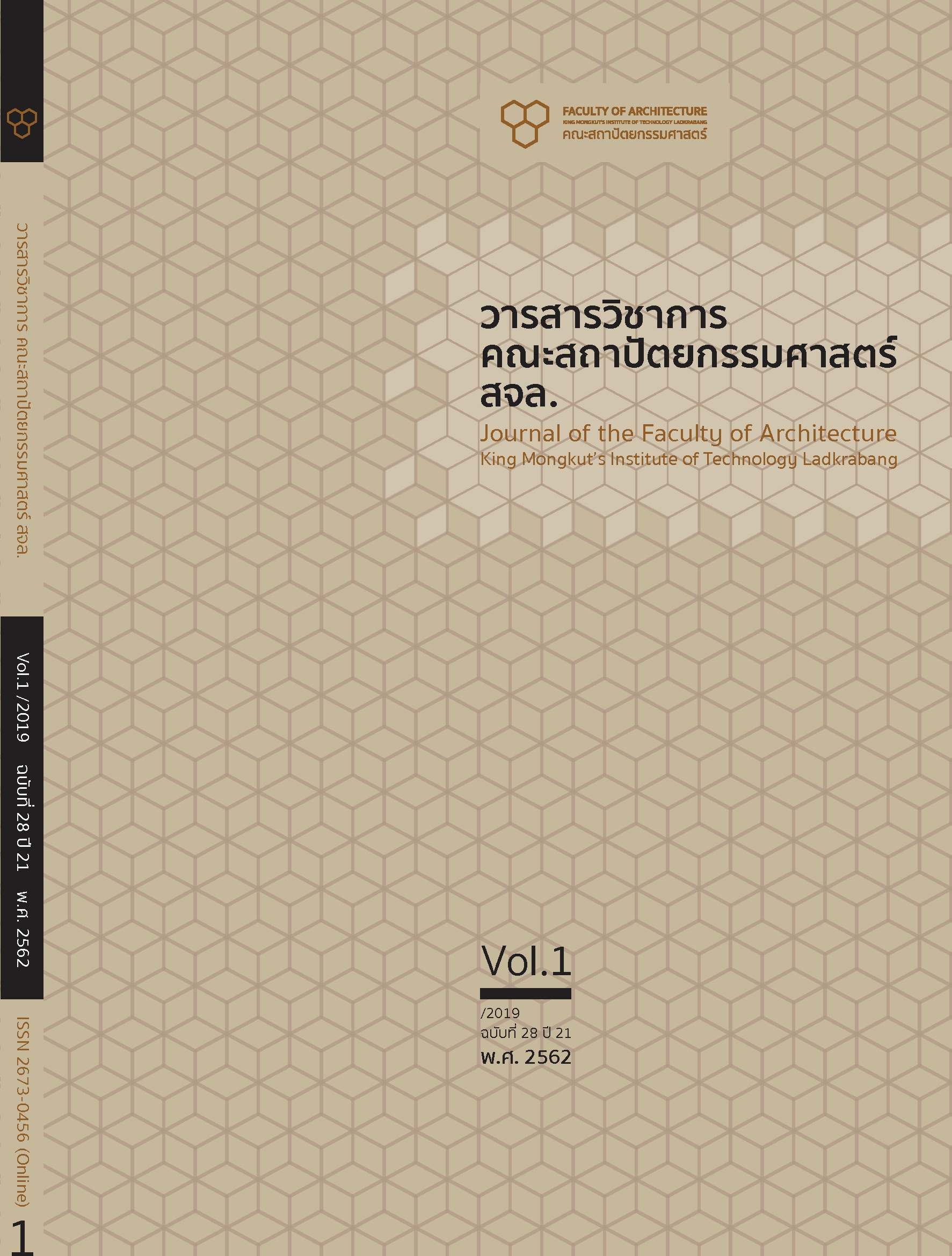Clustering of Thesis Topics in 3D-based Communication Design
Main Article Content
Abstract
บทคัดย่อ
การวิจัยครั้งนี้มีวัตถุประสงค์เพื่อจัดกลุ่มหัวข้อศิลปนิพนธ์ ผ่านการวิเคราะห์องค์ประกอบในการสร้างหัวข้อศิลปนิพนธ์ของนักศึกษา เชื่อมโยงกับกระบวนการทางการออกแบบสื่อสาร ขั้นตอนการศึกษาวิจัย ใช้การประยุกต์ระเบียบวิธีวิจัยเชิงคุณภาพแบบศึกษาทฤษฎีฐานราก ประกอบไปด้วยกระบวนการวิเคราะห์เนื้อหา การวิเคราะห์สกัดหาปัจจัย การเข้ารหัสปัจจัยจัดประเภทหัวข้อศิลปนิพนธ์ ผ่านการใช้ตารางจัดกลุ่มแบบไม่สมมาตรเพื่อเปรียบเทียบ และสังเคราะห์ความเหมือน หรือความแตกต่างของหัวข้อศิลปนิพนธ์แต่ละประเภท ผลของการวิจัยสามารถแบ่งกลุ่ม และคัดแยก องค์ประกอบของศิลปนิพนธ์ทางการออกแบบสนเทศสามมิติได้ทั้งสิ้น 2 กลุ่มใหญ่ คือ กลุ่มเน้นทักษะฝีมือทางการออกแบบ ประกอบไปด้วยศิลปนิพนธ์ 9 ประเภท ได้ แก่ (1) การออกแบบบรรจุภัณฑ์ (2) การออกแบบกราฟิกสภาพแวดล้อมเพื่อการนำทาง (3) การออกแบบกราฟิกสภาพแวดล้อมเพื่อสร้างอัตลักษณ์สถานที่ (4) การออกแบบกราฟิกสภาพแวดล้อมเพื่อการเล่าเรื่องหรือนิทรรศการ (5) การออกแบบซุ้มและการจัดแสดง (6) การออกแบบสินค้าและของที่ระลึก (7) การออกแบบ ทัศนศิลป์ เชิงทดลอง (8) การออกแบบวิธีการออกแบบทัศนศิลป์ และ (9) การออกแบบเกมดิจิทัลเชิงประยุกต์ กลุ่มเน้นทักษะทางการคิดเชิงออกแบบ ประกอบไปด้วยศิลปนิพนธ์ 5 ประเภท ได้แก่ (1) การออกแบบสื่อการเรียนรู้ (2) การออกแบบแคมเปญเพื่อการสื่อสาร (3) การออกแบบแอปพลิเคชั่นสำหรับระบบบริการดิจิทัล (4) การออกแบบธุรกิจดิจิทัล และ (5) การออกแบบสารสนเทศ
คำสำคัญ: การจัดกลุ่ม โจทย์ทางการออกแบบ ศิลปนิพนธ์
Abstract
This research focused on clustering different types of research topics in 3D-based communication design from diverse factors and components through communication design process. This research used qualitative research method by applying grounded theory approach to analyze the data with the technique of content analysis, coding, and using the asymmetry clustering matrix to recognize the affinity and difference of each thesis topic theme in 3D-based communication design. The result revealed 2 categories of research themes, which are design skill-focused, and design thinking-focused. The design skill-focused features (1) packaging design, (2) wayfinding environmental graphic design, (3) place-making environmental graphic design, (4) storytelling environmental graphic or exhibition design, (5) booth and display design, (6) good and souvenir design, (7) visual design experiment, (8) visual method design, and (9) digital gamification design. The design thinking-focused contains (1) learning object design, (2) communication campaign, (3) digital service application design, (4) digital startup, and (5) information design.
Keywords: Clustering, Design Problem, Thesis
Article Details
This work is licensed under a Creative Commons Attribution-NonCommercial-ShareAlike 4.0 International License.
Copyright Transfer Statement
The copyright of this article is transferred to Journal of The Faculty of Architecture King Mongkut's Institute of Technology Ladkrabang with effect if and when the article is accepted for publication. The copyright transfer covers the exclusive right to reproduce and distribute the article, including reprints, translations, photographic reproductions, electronic form (offline, online) or any other reproductions of similar nature.
The author warrants that this contribution is original and that he/she has full power to make this grant. The author signs for and accepts responsibility for releasing this material on behalf of any and all co-authors.
References
Best, K. (2006). Design management: Managing design strategy, process and implementation. La Vergne, TN: AVA Publishing.
Borja De Mozota, B. (2003). Design management: Using design to build brand value and corporate innovation. New York, NY: Allworth Press.
Buchanan, R. (1992). Wicked problems in design thinking. Design Issues. 8(2), 5-21.
Buchanan, R. (1998). Education and professional practice in design. Design Issues. 14(2), 63-66.
Buchanan, R. (1999). Design research and the new learning. Design Issues. 17(4), 3-23.
Buchanan, R. (2004). Human-centered design: Changing perspectives on design education in the east and west. Design Issues. 20(1), 30-39.
Cross, N. (1993). A history of design method. In M. d. Vries, N. Cross, & D. P. Grant (Eds.), Design methodology and relationship with science. (pp. 15-27). Netherlands: Springer.
Danish Design Center. (2015). The design ladder: Four steps of design use. Retrieved from: https://danskdesigncenter.dk/en/design-ladder-four-steps-design-use.
Davis, M., & Hunt, J. (2017). Visual communication design: An introduction to design concepts in everyday experience. New York, NY: Bloomsbury Visual Arts.
Gwilt, I., & Williams, J. (2011). Framing futures for visual communication design research. Design Principles and Practices: An International Journal. 5(5), 81-98.
Lamb, C.W., Hair, J.F., & McDaniel, C. (2014). MKTG7. Mason, OH: South-Western, Cengage Learning.
McAuley, M., & Hodgkinson, G. (2017). The research poster and how it consolidates and communicates key concepts of research inquiry. Design Principles and Practices: An International Journal. 11(1), 1-14.
Parente, D. E. (2006). Advertising Campaign Strategy: A Guide to marketing communication plans (4th ed.). Mason, OH: South-Western Cengage Learning.
Poggenpohl, S., & Winkler, D. R. (2010). What have we learned from communication design failure?. Visible Language. 44(1), 127-139.
Powers, J.H. (1995). On the intellectual structure of the human communication discipline. Communication Education. 44(3), 191-222.
Sissors, J. Z., & Baron, R. B. (2010). Advertising Media Planning. 7th ed. United States of America: The McGraw-Hill.
Stolterman, E. (2008). The nature of design practice and implication for interaction design research. International Journal of Design. 2(1), 55-65.
Swann, C. (2002). Action research and the practice of design. Design Issues. 18(2), 49-61.
Wallschlaeger, C., & Busic-Snyder, C. (1992). Basic visual concepts and principles for artists, architects, and designers. United States of America: McGraw-Hill.
Zurlo, F., & Cautela, C. (2014). Design strategies in different narrative frames. Design Issues. 30(1), 19-35.


